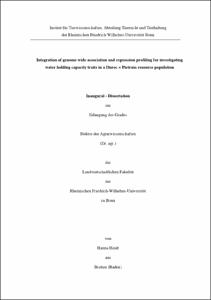Heidt, Hanna: Integration of genome wide association and expression profiling for investigating water holding capacity traits in a Duroc × Pietrain resource population. - Bonn, 2013. - Dissertation, Rheinische Friedrich-Wilhelms-Universität Bonn.
Online-Ausgabe in bonndoc: https://nbn-resolving.org/urn:nbn:de:hbz:5n-34589
Online-Ausgabe in bonndoc: https://nbn-resolving.org/urn:nbn:de:hbz:5n-34589
@phdthesis{handle:20.500.11811/5570,
urn: https://nbn-resolving.org/urn:nbn:de:hbz:5n-34589,
author = {{Hanna Heidt}},
title = {Integration of genome wide association and expression profiling for investigating water holding capacity traits in a Duroc × Pietrain resource population},
school = {Rheinische Friedrich-Wilhelms-Universität Bonn},
year = 2013,
month = dec,
volume = 167,
note = {Water holding capacity (WHC) is an important quality criterion for the consumers and the meat processing industries. Therefore, the aim of this study was to investigate WHC traits in the Duroc × Pietrain resource population (DuPi) using genome-wide association and genetical genomics approaches.
In the first step, 169 F2 DuPi animals were genotyped using the porcine 60K SNP chip and four meat quality traits (drip loss, pH1, pH24 and pH decline) were used to investigate the genetic background of WHC. 49, 40, 9 and 33 significant SNP were observed (P < 0.001) for drip loss, pH1, pH24 and pH decline in loin, respectively. Analyses revealed 14 functional candidate genes significantly associated with drip loss. 26, 7 and 22 candidate genes were identified for pH1, pH24 and pH decline, respectively. The genes NELL1 and SOX6 located on SSC2 were significantly associated with drip loss and showed more than 3 point-mutations each with high linkage disequilibrium. The proportion of explained phenotypic variance ranged between 4.4 % and 8.43 % for identified SNP of all four traits.
In the second step, WHC was characterized by drip loss measured in M. longissimus dorsi. Performing expression analyses of transcriptional profiles for 132 F2 DuPi animals revealed 1228 genes, which were significantly correlated with drip loss. A hyper geometric gene set enrichment test was performed and glycolysis/glyconeogenesis, pentose phosphate pathway and pyruvat metabolism were identified as most promising pathways. For 267 selected transcripts, eQTL analyses revealed 1541 significant associations in total. Because of positional accordance of the gene underlying transcript and the eQTL location, it was possible to identify 8 eQTL that could be assumed as cis-regulated. Comparing the results of gene set enrichment and the eQTL detection tests, molecular networks and potential candidate genes, which seem to play key roles in the expression of WHC, were detected.
In conclusion, applying a genome wide association analysis using the 60K porcine SNP panel allowed to investigate the genetic background of WHC traits in this study. Combing the genome-wide association analysis with the genetical genomics approach supports to identify WHC trait-associated SNP and to understand the biology of complex traits.},
url = {https://hdl.handle.net/20.500.11811/5570}
}
urn: https://nbn-resolving.org/urn:nbn:de:hbz:5n-34589,
author = {{Hanna Heidt}},
title = {Integration of genome wide association and expression profiling for investigating water holding capacity traits in a Duroc × Pietrain resource population},
school = {Rheinische Friedrich-Wilhelms-Universität Bonn},
year = 2013,
month = dec,
volume = 167,
note = {Water holding capacity (WHC) is an important quality criterion for the consumers and the meat processing industries. Therefore, the aim of this study was to investigate WHC traits in the Duroc × Pietrain resource population (DuPi) using genome-wide association and genetical genomics approaches.
In the first step, 169 F2 DuPi animals were genotyped using the porcine 60K SNP chip and four meat quality traits (drip loss, pH1, pH24 and pH decline) were used to investigate the genetic background of WHC. 49, 40, 9 and 33 significant SNP were observed (P < 0.001) for drip loss, pH1, pH24 and pH decline in loin, respectively. Analyses revealed 14 functional candidate genes significantly associated with drip loss. 26, 7 and 22 candidate genes were identified for pH1, pH24 and pH decline, respectively. The genes NELL1 and SOX6 located on SSC2 were significantly associated with drip loss and showed more than 3 point-mutations each with high linkage disequilibrium. The proportion of explained phenotypic variance ranged between 4.4 % and 8.43 % for identified SNP of all four traits.
In the second step, WHC was characterized by drip loss measured in M. longissimus dorsi. Performing expression analyses of transcriptional profiles for 132 F2 DuPi animals revealed 1228 genes, which were significantly correlated with drip loss. A hyper geometric gene set enrichment test was performed and glycolysis/glyconeogenesis, pentose phosphate pathway and pyruvat metabolism were identified as most promising pathways. For 267 selected transcripts, eQTL analyses revealed 1541 significant associations in total. Because of positional accordance of the gene underlying transcript and the eQTL location, it was possible to identify 8 eQTL that could be assumed as cis-regulated. Comparing the results of gene set enrichment and the eQTL detection tests, molecular networks and potential candidate genes, which seem to play key roles in the expression of WHC, were detected.
In conclusion, applying a genome wide association analysis using the 60K porcine SNP panel allowed to investigate the genetic background of WHC traits in this study. Combing the genome-wide association analysis with the genetical genomics approach supports to identify WHC trait-associated SNP and to understand the biology of complex traits.},
url = {https://hdl.handle.net/20.500.11811/5570}
}






